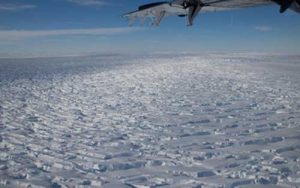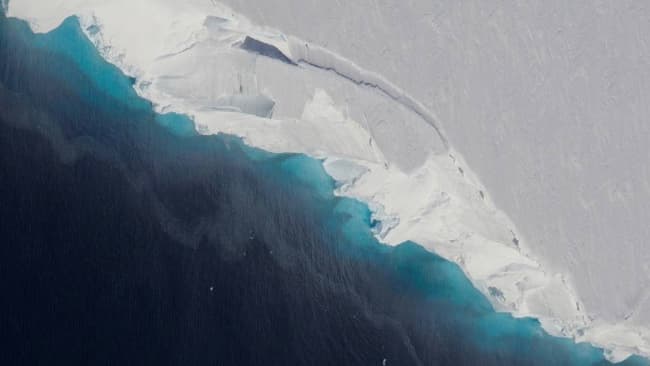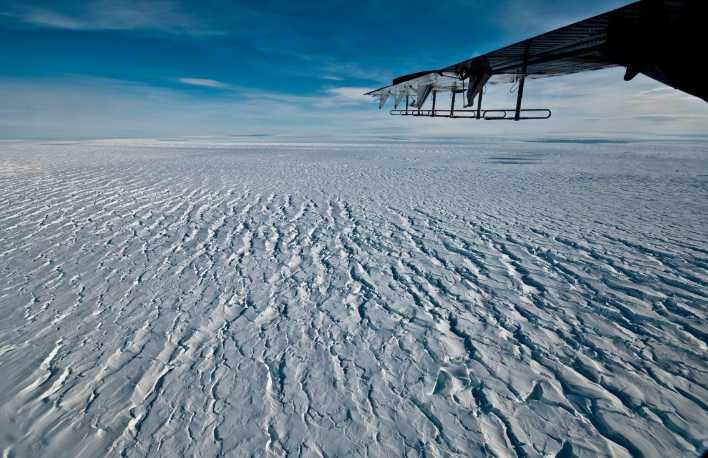
The collapse of the Thwaites Glacier in West Antarctica could significantly affect global sea levels. As part of a new $25 million research collaboration, the National Science Foundation (NSF) and the United Kingdom’s Natural Environment Research Council (NERC) announced today that teams of scientists at U.S. institutions will deploy to Antarctica to gather the data needed to understand whether the glacier could begin to collapse in the next few decades or centuries from now.
The research collaboration, called the International Thwaites Glacier Collaboration (ITGC), was announced at the British Antarctic Survey (BAS) headquarters in Cambridge, England. The collaboration’s scientists will begin their first research season in Antarctica in October, establishing a logistical support structure for future work. The collaboration will continue until 2021.
Reducing scientific uncertainty about the likelihood, timing and magnitude of the collapse of West Antarctic glaciers is an international priority recently underscored by the Scientific Committee on Antarctic Research in its report Horizon Scan 2020.
In addition, a recent report by the U.S. National Academy of Sciences, Engineering, and Medicine cited the development of enhanced capabilities to predict ice loss from West Antarctica as a top priority for Antarctic research.
The Thwaites Glacier already drains an area roughly the size of Britain or the state of Florida, accounting for about 4 percent of global sea level rise — an amount that has doubled since the mid-1990s.
“Satellites show the Thwaites region is changing rapidly,” said William Easterling, NSF assistant director for Geosciences. “To answer the key questions of how much and how quickly sea level will change requires scientists on the ground with sophisticated equipment collecting the data we need to measure rates of ice-volume or ice-mass change. The challenges of conducting fieldwork of this scope and scale in such remote locations are enormous. The only practical way for nations to do this is to work collaboratively, each bringing scientific and logistical resources to enable complex and comprehensive field studies.”
The Office of Polar Programs in NSF’s Geosciences Directorate manages the U.S. Antarctic Program, which will support the collaboration’s researchers and provide U.S. logistics for the project.
“The fate of the Thwaites Glacier is one the big unknowns in Antarctic science,” said Duncan Wingham, NERC’s chief executive. “We currently do not know enough about the likelihood, timing and magnitude of the collapse of West Antarctic glaciers such as Thwaites to be able to plan accordingly. NERC and NSF, working together, are uniquely placed to attempt to reduce the scientific uncertainty about these unknowns, providing answers to one of the most important questions facing us about global sea level rise.”[xyz-ihs snippet=”adsense-body-ad”]The ITGC is the largest joint project undertaken by the two nations in Antarctica in more than 70 years, since the conclusion of a mapping project on the Antarctic Peninsula in the late 1940s.
The collaboration involves about 100 scientists from the world’s foremost research institutes in both countries alongside researchers from other nations, including South Korea, Germany, Sweden, New Zealand and Finland, who will contribute to the various projects.
“Whilst Antarctica seems far away, what is happening there is already affecting sea-levels around the world,” said David Vaughan, director of science at the British Antarctic Survey and lead scientific coordinator for the U.K. “U.K. and U.S. scientists have a track record of working well together on the ice, and together we have a unique opportunity to change our understanding of Antarctica, and to make a difference by helping to provide the information we need to help protect coastal cities, ecosystems and vulnerable communities around the world.”
Antarctica’s glaciers contribute to sea level rise when more ice is lost to the ocean than snow replaces. A full understanding of the causes of changes in ice flow requires study of the ice itself, the nearby ocean, and the Antarctic climate in the region.
In addition to the $25 million in awards to the research teams, the costs of the logistics of mounting a scientific campaign in one of the most remote places in Antarctica will increase the commitment significantly.
The nearest permanently occupied research station to the Thwaites Glacier is roughly 900 miles away, so transporting the scientists to the research site will take a massive joint effort from both nations. While researchers on the ice will rely on aircraft support from U.K. and U.S. research stations, oceanographers and geophysicists will approach the glacier from the sea aboard research icebreakers.
The program will deploy the most up-to-date instruments and techniques available, from drills that can bore access holes 1,500 meters into the ice to autonomous submarines such as the Autosub Long Range, affectionately known around the world as Boaty McBoatface.
Kelly Falkner, director of NSF’s Office of Polar Programs, noted that the U.S. Antarctic program has “decades of experience in supporting large-scale international research initiatives — from building the world’s largest neutrino detector at the South Pole to supporting ice-core and sediment drilling projects that provide glimpses into the thawing and freezing of Antarctica over timescales of millions of years.”
Despite the challenges, the only practical way to understand what changes are underway at the Thwaites is to go there, noted lead U.S. scientific coordinator, Ted Scambos, of the National Snow and Ice Data Center in Colorado.[xyz-ihs snippet=”Adversal-468×60″]”For more than a decade, satellites have identified this area as a region of massive ice loss and rapid change,” he said. “But there are still many aspects of the ice and ocean that cannot be determined from space. We need to go there, with a robust scientific plan of activity, and learn more about how this area is changing in detail, so we can reduce the uncertainty of what might happen in the future.”
NSF and NERC, through the ITGC, are jointly funding eight research projects and a coordination grant.
Geophysical Habitat of Subglacial Thwaites (GHOST)
Sridhar Anandakrishnan, Penn State University; Andy Smith, British Antarctic Survey
Using seismic and radar methods on the ice, GHOST will investigate and quantify the sediment, hydrology and bedrock underlying the glacier.
Melting at Thwaites Grounding Zone and Its Control on Sea Level (THWAITES-MELT)
Keith Nicholls, British Antarctic Survey; David Holland, New York University
This project will measure the melting at the glacier’s ice-ocean interface to understand the processes involved and its potential for triggering increased sea level rise.
Thwaites-Amundsen Regional Survey and Network (TARSAN)
Karen Heywood, University of East Anglia; Erin Pettit, University of Alaska Fairbanks
TARSAN will investigate how the ocean and atmosphere are affecting the glacier by measuring ocean circulation and thinning beneath the floating part of the glacier with state-of-the-art technology, such as autonomous underwater vehicles and automated land-ice stations.
Geological History Constraints on Grounding Line Retreat in the Thwaites Glacier system (GHC)
Joanne Johnson, British Antarctic Survey; Brent Goehring, Tulane University
Sampling bedrock beneath the ice sheet, GHC will identify if and when the glacier retreated in the past, how it recovered, and how it is currently responding to environmental conditions.
Thwaites Interdisciplinary Margin Evolution (TIME):
Slawek Tulaczyk, University of California, Santa Cruz; Poul Christoffersen, Scott Polar Research Institute
Using a variety of techniques such as radar and seismic analysis to understand the margins of the glacier, TIME will investigate what controls its width and speed.
Thwaites Glacier Offshore Research (THOR)
Julia Wellner, University of Houston; Robert Larter, British Antarctic Survey
Investigating sediments deposited in the seas near the glacier, THOR will reconstruct past changes in environmental conditions and the glacier’s response to these, thereby adding context to our projections of future change.
Disintegration of Marine Ice Sheets Using Novel Optimized Simulations (DOMINOS)
Doug Benn, University of St. Andrews; Jeremy Bassis, University of Michigan
The DOMINOS team will use computer modelling to examine calving and associated processes that could cause the rapid retreat and collapse of the glacier.
Processes, Drivers, Predictions: Modelling the History and Evolution of Thwaites Glacier (PROPHET)
Mathieu Morlinghem, University of California, Irvine, and Hilmar Gudmundsson, University of Northumbria
By combining existing computer simulations of ice and ocean near the Glacier, PROPHET will improve models to reduce the uncertainty in the projection of the glacier’s behaviour and subsequent contribution to sea level rise in the future.
Thwaites Science Coordination Office (SCO)
David Vaughan, British Antarctic Survey; Ted Scambos, University of Colorado
Working for the eight ITGC projects, the SCO will integrate for efficiency and effectiveness, foster wider scientific collaboration, and deliver crucial science outcomes to key stakeholders.
Source: NSF







